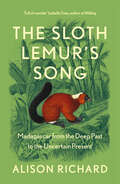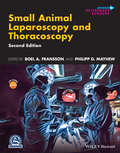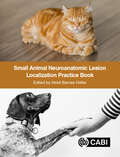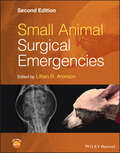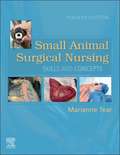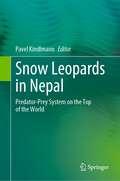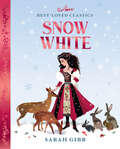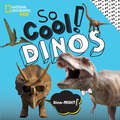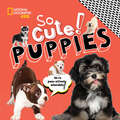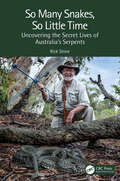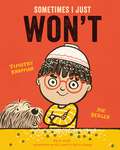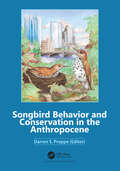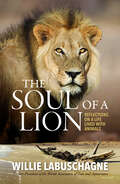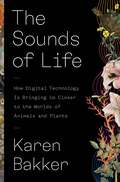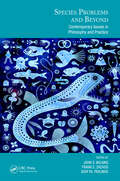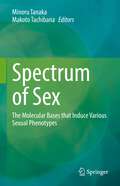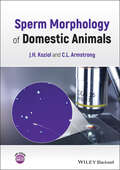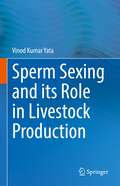- Table View
- List View
The Sloth Lemur’s Song: Madagascar From The Deep Past To The Uncertain Present
by Alison Richard‘Full of wonder and forensic intelligence’ Isabella Tree, author of Wilding A moving account of Madagascar told by a researcher who has spent over fifty years investigating the mysteries of this remarkable island.
Small Animal Laparoscopy and Thoracoscopy (AVS Advances in Veterinary Surgery)
by Boel A. Fransson Philipp D. MayhewThe newly revised Second Edition of Small Animal Laparoscopy and Thoracoscopy is a rigorous update of the first book to provide comprehensive and current information about minimally invasive surgery in dogs and cats. With a focus on techniques in rigid endoscopy, the book also includes guidance on additional surgeries outside the abdomen and chest. New chapters describe newly developed surgical techniques, while existing chapters have been thoroughly updated. The authors include detailed stepwise instructions for each procedure, including clinical photographs. Pre-operative considerations, patient positioning, portal placement, and postoperative care are also discussed, with key points of consideration outlined for each surgery. Purchasers of the book will also receive access to a companion website featuring video clips of the fundamental skills and surgical techniques described in the resource. The book also offers: An introduction to laparoscopic suturing and knot tying with accompanying video tutorials A thorough introduction to the equipment used in laparoscopic and thoracoscopic veterinary surgeries, including imaging equipment, surgical instrumentation, energy devices, and stapling equipment Clear explanations of foundational techniques in laparoscopy, including laparoscopic anesthesia, access techniques, contraindications, complications, and conversion Robust descriptions of fundamental techniques in thoracoscopy, including patient positioning, port placement, contraindications, complications, and conversion Discussions of a wide variety of laparoscopic and thoracoscopic surgical procedures Small Animal Laparoscopy and Thoracoscopy is an essential reference for veterinary surgeons, veterinary internal medicine specialists and residents, and small animal general practitioners seeking a one-stop reference for minimally invasive surgery in dogs and cats.
Small Animal Laparoscopy and Thoracoscopy (AVS Advances in Veterinary Surgery)
by Boel A. Fransson Philipp D. MayhewThe newly revised Second Edition of Small Animal Laparoscopy and Thoracoscopy is a rigorous update of the first book to provide comprehensive and current information about minimally invasive surgery in dogs and cats. With a focus on techniques in rigid endoscopy, the book also includes guidance on additional surgeries outside the abdomen and chest. New chapters describe newly developed surgical techniques, while existing chapters have been thoroughly updated. The authors include detailed stepwise instructions for each procedure, including clinical photographs. Pre-operative considerations, patient positioning, portal placement, and postoperative care are also discussed, with key points of consideration outlined for each surgery. Purchasers of the book will also receive access to a companion website featuring video clips of the fundamental skills and surgical techniques described in the resource. The book also offers: An introduction to laparoscopic suturing and knot tying with accompanying video tutorials A thorough introduction to the equipment used in laparoscopic and thoracoscopic veterinary surgeries, including imaging equipment, surgical instrumentation, energy devices, and stapling equipment Clear explanations of foundational techniques in laparoscopy, including laparoscopic anesthesia, access techniques, contraindications, complications, and conversion Robust descriptions of fundamental techniques in thoracoscopy, including patient positioning, port placement, contraindications, complications, and conversion Discussions of a wide variety of laparoscopic and thoracoscopic surgical procedures Small Animal Laparoscopy and Thoracoscopy is an essential reference for veterinary surgeons, veterinary internal medicine specialists and residents, and small animal general practitioners seeking a one-stop reference for minimally invasive surgery in dogs and cats.
Small Animal Neuroanatomic Lesion Localization Practice Book
by Susan Arnold Joy Delamaide Gasper Kari Foss Julian Guevar Devon Hague Sam Long Simon Platt Helena RylanderNeuroanatomic lesion localization (detecting where a neurologic problem arises) is key when presented with a dog or cat with signs of neurologic disease. The correct neuroanatomic lesion localization will drive veterinarians towards an appropriate list of differential diagnoses and help lead the client towards applicable diagnostic investigation. Neuroanatomic lesion localization is the first step when managing any pet with signs of neurologic disease. Despite its importance, it remains a challenge for veterinary students, residents and practitioners in their daily practice. Laid out in a case-based format and workbook style to guide the reader through neuroanatomic lesion localization, this book: Covers the whole process from the animal's examination through to diagnosis; Includes localizations of intercranial disease, spinal cord disease, neuromuscular disease and multifocal disease; Provides blank practice sheets to encourage the reader to work through cases, testing and consolidating their knowledge multiple times. Written by a team of eminent, international veterinary neurologists, this book is an invaluable resource for veterinary students and practitioners looking to expand their skills in veterinary neurology.
Small Animal Surgical Emergencies
by Lillian R. AronsonSmall Animal Surgical Emergencies A comprehensive and up-to-date guide in emergency surgical intervention for veterinary professionals Small Animal Surgical Emergencies, Second Edition continues to be an important resource focusing on surgical emergencies, combining the work of surgical specialists and critical care specialists, and filling a void in educating and informing veterinarians. The new edition of this book provides updated information on an array of topics such as preoperative stabilization, new and innovative treatment options, and aftercare. Each chapter covers step-by-step information on emergency stabilization, diagnostic approach, operative techniques, postoperative care, common complications encountered in each case, and how to troubleshoot any such complication should they occur. It also offers simplified surgical techniques to ensure success and describes new and novel procedures throughout. The Second Edition of Small Animal Surgical Emergencies features: Nine new chapters covering operating room nursing tips, rectal prolapse, colonic torsion, surgical intervention post celiotomy, assisted enteral feeding tubes, open chest CPR, managing complications of skin flaps and grafts, incisional infection, and joint luxations Many chapters are written in collaboration by experts in small animal surgery and critical care, combining these practices in one important resource Relevant anatomy, imaging, and full-color illustrations and drawings incorporated into each chapter Inclusion of case presentations, when relevant An important tool for small animal general practitioners, veterinary surgeons, critical care specialists, as well as veterinary nurses and operating room technicians, Small Animal Surgical Emergencies, Second Edition is a crucial resource for this constantly evolving branch of veterinary medicine.
Small Animal Surgical Emergencies
by Lillian R. AronsonSmall Animal Surgical Emergencies A comprehensive and up-to-date guide in emergency surgical intervention for veterinary professionals Small Animal Surgical Emergencies, Second Edition continues to be an important resource focusing on surgical emergencies, combining the work of surgical specialists and critical care specialists, and filling a void in educating and informing veterinarians. The new edition of this book provides updated information on an array of topics such as preoperative stabilization, new and innovative treatment options, and aftercare. Each chapter covers step-by-step information on emergency stabilization, diagnostic approach, operative techniques, postoperative care, common complications encountered in each case, and how to troubleshoot any such complication should they occur. It also offers simplified surgical techniques to ensure success and describes new and novel procedures throughout. The Second Edition of Small Animal Surgical Emergencies features: Nine new chapters covering operating room nursing tips, rectal prolapse, colonic torsion, surgical intervention post celiotomy, assisted enteral feeding tubes, open chest CPR, managing complications of skin flaps and grafts, incisional infection, and joint luxations Many chapters are written in collaboration by experts in small animal surgery and critical care, combining these practices in one important resource Relevant anatomy, imaging, and full-color illustrations and drawings incorporated into each chapter Inclusion of case presentations, when relevant An important tool for small animal general practitioners, veterinary surgeons, critical care specialists, as well as veterinary nurses and operating room technicians, Small Animal Surgical Emergencies, Second Edition is a crucial resource for this constantly evolving branch of veterinary medicine.
Small Animal Surgical Nursing - E-Book
by Marianne TearMaster the veterinary technician's role and skills in surgical assisting! Small Animal Surgical Nursing, 4th Edition helps you learn the protocols and techniques you need to work together with the veterinarian as a smoothly functioning surgical team. Clear guidelines are provided in areas such as surgical instruments and procedures, anesthesia, patient monitoring, preoperative and postoperative care of the animals, pain management, and client education. This edition is updated throughout and includes timed instrument identification exercises on the Evolve website. Written by well-known educator Marianne Tear, this comprehensive resource ensures that you are highly competent in performing all of the vet tech’s surgical responsibilities.Coverage of small animal surgical nursing provides a full review of the role and responsibilities of the veterinary technician in the surgical setting, including sterilization, protocols, gowning, gloving, anesthesia, wound management, and care of the animals before and after surgery.Focus on exceptional clinical skills and practice tips draws from the author’s real-world experiences of what is most commonly encountered in the clinical setting.Nearly 500 full-color illustrations and photographs show surgical equipment, instruments, sterile techniques, suturing techniques, and wound management.Attention to detail ensures understanding of the skills covered in required veterinary technician surgical nursing courses.Learning Objectives and Key Terms at the beginning of each chapter identify the material that should be mastered in the upcoming chapter.Key Points and Review Questions at the end of each chapter facilitate study and reinforce understanding.Quick Reference for Common IV Infusions and Analgesic Protocols appendix helps students learn to work quickly and efficiently.NEW! Updated content and new protocols and skills ensure that students have the latest information available.NEW! Updated and additional Review Questions include multiple-choice, listing, and open-ended questions that challenge students to apply the knowledge they have learned in each chapter.
Snow Leopards in Nepal: Predator-Prey System on the Top of the World
by Pavel KindlmannSnow leopard (Panthera uncia) is an endangered species, and its population size is steadily declining. The main threats to the snow leopard include illegal trade, conflict with locals (human-snow leopard conflict), lack of conservation, awareness and policy, and climate change. To avoid its extinction, we badly need a good knowledge of its ecology, distribution and population dynamics, including interactions with its prey, which will take into account various scenarios of changes in climate and human impact on snow leopard. This book aims to put together a considerable amount of unpublished data collected by the co-author of most of the chapters, Bikram Shrestha, which might be useful for other researchers working on snow leopard. In addition, researchers might find it useful to have a key for determining the diet of snow leopard based on remnants of its food in its scats. Last, but not least, based on the difficulty we experienced trying to compare and combine different sets of results, we propose a general methodology for collecting data. Thus, this book is not an all-encompassing compendium, but an attempt to fill some gaps in the literature and to show, how to publish new data on snow leopard in a useful and workable way. The first part, describing the main features of snow leopard and its main prey ecology, is followed by a comprehensive review of data available on its abundance and threats to its survival. The third, most extensive part—the substance of the book—presents new data from 15 years of intensive camera trapping combined with scat sampling. These data are analyzed by means of advances GIS and genetic techniques, which yields a large amount of conservation implications.The purpose of this book is to provide a tool for both environmental managers and researchers to find quickly what is known about this species for conservation planning and for an effective protection of snow leopard. However, enthusiasts interested in wild cats may welcome the book, too.
Snow White (Best-Loved Classics)
by Sarah GibbA beautifully illustrated, magical retelling of one of the most beloved children’s fairy tales.
So Cool! Dinos (National Geographic Kids)
by National Geographic KidsThose sharp, pointy teeth! Those terrifying claws! Those spikey spines and ferocious roars! Let's face it…dinosaurs are SO COOL! And, well, so is this book!
So Cute! Puppies (National Geographic Kids)
by National Geographic KidsThat wrinkly little face. Those sweet puppy dog eyes. That squishy, pudgy, fuzzy body…let's face it: Puppies are SO CUTE! And, well, so is this book!
So Many Snakes, So Little Time: Uncovering the Secret Lives of Australia’s Serpents
by Rick ShineSnakes are creatures of mystery, arousing fear in many people but fascination in a few. Recent research has transformed our understanding of the behaviour and ecology of these animals, revealed their important roles in diverse ecosystems, and discovered new and effective ways to conserve their populations and to promote coexistence between snakes and people. One of the leading contributors to that scientific revolution has been Prof Rick Shine. Based in Australia, whose snake fauna is diverse and often dangerous, his experiences and anecdotes will inspire a new generation of serpent scientists. Spellbinding stories highlight the challenges, frustrations, and joys of discovery, and give the reader a greater appreciation of these often-slandered slithering reptiles.Key Features Documents the important role played by a preeminent herpetologist. Focuses on research conducted in Australia, especially on snakes. Summarizes highly influential conservation studies. Explores the ways in which research has deepened our understanding of snakes.
So Many Snakes, So Little Time: Uncovering the Secret Lives of Australia’s Serpents
by Rick ShineSnakes are creatures of mystery, arousing fear in many people but fascination in a few. Recent research has transformed our understanding of the behaviour and ecology of these animals, revealed their important roles in diverse ecosystems, and discovered new and effective ways to conserve their populations and to promote coexistence between snakes and people. One of the leading contributors to that scientific revolution has been Prof Rick Shine. Based in Australia, whose snake fauna is diverse and often dangerous, his experiences and anecdotes will inspire a new generation of serpent scientists. Spellbinding stories highlight the challenges, frustrations, and joys of discovery, and give the reader a greater appreciation of these often-slandered slithering reptiles.Key Features Documents the important role played by a preeminent herpetologist. Focuses on research conducted in Australia, especially on snakes. Summarizes highly influential conservation studies. Explores the ways in which research has deepened our understanding of snakes.
Sometimes I Just WON'T
by Timothy KnapmanSometimes I Just WON'T is a hilarious and helpful book about the ever-changing moods of small children, from top picture book pairing, Timothy Knapman and Joe Berger.Being a toddler is an emotional rollercoaster. Some days you want to put your coat on, you don’t mind sharing and you can't wait to have your bath. There are days when you're the first to slide down the biggest slide, or join in with everyone else. But some days, you just WON'T! And sometimes that’s OK. But, with a little kindness and encouragement, you might find that something you don’t want to do can become something you love to do!A comic look at child autonomy and how to navigate strong emotions. An essential read for all young children – and their adults because, big or small, sometimes we ALL need to feel in charge. With bouncing rhythmic text and lively, graphic illustrations this is a brilliant follow up to Sometimes I am Furious, a Sunday Times Book of the Year 2021!
Songbird Behavior and Conservation in the Anthropocene
by Darren S. ProppeLearned and fixed behaviors underlie many of the patterns we observe in songbirds. But the environmental context in which these patterns occur is changing quickly, often to the detriment of the individual and species. The goal of this book is to weave concepts of behavior more tightly into our conservation strategies. Each chapter describes the current understanding of behavior in relation to a particular songbird life history trait. The authors then evaluate challenges that songbirds face in the Anthropocene, and explore the role of behavior in addressing these challenges. The future is uncertain for songbirds, but broadening our management toolkit will increase the potential for success.
Songbird Behavior and Conservation in the Anthropocene
by Darren S. ProppeLearned and fixed behaviors underlie many of the patterns we observe in songbirds. But the environmental context in which these patterns occur is changing quickly, often to the detriment of the individual and species. The goal of this book is to weave concepts of behavior more tightly into our conservation strategies. Each chapter describes the current understanding of behavior in relation to a particular songbird life history trait. The authors then evaluate challenges that songbirds face in the Anthropocene, and explore the role of behavior in addressing these challenges. The future is uncertain for songbirds, but broadening our management toolkit will increase the potential for success.
The Soul of a Lion: Reflections on a life lived with animals
by Willie LabuschagneThe Soul of a Lion, an engaging memoir by Willie Labuschagne, is an exhilarating journey which begins with the young conservationist’s unique experiences with wild animals. From his groundbreaking research on the desert cheetah’s behaviour and ecology to becoming an internationally respected consultant on environmental and wildlife-related issues, he holds the reader’s attention with all the skill of the master storyteller.The numerous occasions when Willie faced potentially life-threatening situations with wild animals are vividly recounted, many of them wryly humorous while others evoke deep emotion.But not all animal encounters took place in the wild. A significant and poignant encounter that further inspired Willie’s approach to conservation occurred when, during his time as director of the Johannesburg Zoo, he and his family hand-raised a newborn lion cub that had been rejected by its mother.He recalls the countless obstacles put in his way by the bureaucratic nature of his own species during his tenure at the zoo. But despite numerous challenges he persisted in his goal of transforming and improving zoological institutions. A driving force behind the changing nature of professionally managed zoological gardens, Willie’s book reminds us that, while many of the world’s zoos should be unconditionally closed, progressive modern zoos are becoming increasingly aligned to wildlife conservation: they are vital for ensuring the survival of threatened species.Willie shares his entertaining and often moving life experiences with warmth and understanding, whether it is sleeping under the stars with the bushmen of the Kgalagadi desert or observing the traditions of the Zulu Royal House. His travels in the African landscape in particular are an exciting panorama of many distinctive habitats, from the relentless desert of the Skeleton Coast in Namibia to the pristine beauty of the Tsitsikamma Forest and the breathtaking vastness of the African bushveld.Importantly, he is forthright in his view of the critical position of the world we live in and the future it holds for mankind and believes that we are all part of a custodianship which should do everything in its power to protect our fragile environment.Willie Labuschagne, a man with the soul of a lion, is a dedicated and internationally celebrated wildlife conservationist who holds a master’s degree in wildlife management. For more than five decades he has been actively involved in the conservation of threatened species for which he has received national and international recognition, culminating in numerous awards.
The Sounds of Life: How Digital Technology Is Bringing Us Closer to the Worlds of Animals and Plants
by Karen BakkerAn amazing journey into the hidden realm of nature&’s soundsThe natural world teems with remarkable conversations, many beyond human hearing range. Scientists are using groundbreaking digital technologies to uncover these astonishing sounds, revealing vibrant communication among our fellow creatures across the Tree of Life.At once meditative and scientific, The Sounds of Life shares fascinating and surprising stories of nonhuman sound, interweaving insights from technological innovation and traditional knowledge. We meet scientists using sound to protect and regenerate endangered species from the Great Barrier Reef to the Arctic and the Amazon. We discover the shocking impacts of noise pollution on both animals and plants. We learn how artificial intelligence can decode nonhuman sounds, and meet the researchers building dictionaries in East African Elephant and Sperm Whalish. At the frontiers of innovation, we explore digitally mediated dialogues with bats and honeybees. Technology often distracts us from nature, but what if it could reconnect us instead?The Sounds of Life offers hope for environmental conservation and affirms humanity&’s relationship with nature in the digital age. After learning about the unsuspected wonders of nature&’s sounds, we will never see walks outdoors in the same way again.
Species Problems and Beyond: Contemporary Issues in Philosophy and Practice (Species and Systematics)
by John S. Wilkins Frank E. Zachos Igor Ya. PavlinovSpecies Problems and Beyond offers a collection of up-to-date essays discussing from an interdisciplinary perspective the many ramifications of the ‘Species Problem.’ The authors represent experts in the philosophy of biology, in species-level evolutionary investigations, and in biodiversity studies and conservation. Some of the topics addressed concern the context sensitivity of the term ‘species’; species as individuals, processes, natural kinds, or as ‘operative concepts’; species delimitation in the age of Big (genomic) Data; and taxonomic inflation and its consequences for conservation strategies. The carefully edited volume will be an invaluable resource for philosophers of biology and evolutionary biologists alike. – Olivier Rieppel, Rowe Family Curator of Evolutionary Biology, Negaunee Integrative Research Center, Field Museum, USASpecies, or ‘the Species Problem’, is a topic in science, in the philosophy of science, and in general philosophy. In fact, it encompasses many aspects of the same problem, and these are dealt with in this volume. Species are often thought of as fundamental units of biological matter to be used in ecology, conservation, classification, and biodiversity. The chapters in this book present opposing views on the current philosophical and conceptual issues of the Species Problem in biology.Divided into four sections, Concepts and Theories, Practice and Methods, Ranks and Trees and Names, and Metaphysics and Epistemologies, the book is authored by biologists, philosophers, and historians, many leaders in their fields. Topics include ontology of species, definitions of both species category and units, species rank, speciation issues, nomenclature, ecology, and species conservation.Species Problems and Beyond aims to clarify the contemporary issues of the Species Problem. It is ideal for use in upper-level seminars and courses in Evolutionary Biology, Philosophy of Science, Philosophy of Biology, Systematics and Taxonomy, and Phylogenetics/Cladistics, and for any scholar in these fields.
Species Problems and Beyond: Contemporary Issues in Philosophy and Practice (Species and Systematics)
by John S. Wilkins, Frank E. Zachos, and Igor Ya. PavlinovSpecies Problems and Beyond offers a collection of up-to-date essays discussing from an interdisciplinary perspective the many ramifications of the ‘Species Problem.’ The authors represent experts in the philosophy of biology, in species-level evolutionary investigations, and in biodiversity studies and conservation. Some of the topics addressed concern the context sensitivity of the term ‘species’; species as individuals, processes, natural kinds, or as ‘operative concepts’; species delimitation in the age of Big (genomic) Data; and taxonomic inflation and its consequences for conservation strategies. The carefully edited volume will be an invaluable resource for philosophers of biology and evolutionary biologists alike. – Olivier Rieppel, Rowe Family Curator of Evolutionary Biology, Negaunee Integrative Research Center, Field Museum, USASpecies, or ‘the Species Problem’, is a topic in science, in the philosophy of science, and in general philosophy. In fact, it encompasses many aspects of the same problem, and these are dealt with in this volume. Species are often thought of as fundamental units of biological matter to be used in ecology, conservation, classification, and biodiversity. The chapters in this book present opposing views on the current philosophical and conceptual issues of the Species Problem in biology.Divided into four sections, Concepts and Theories, Practice and Methods, Ranks and Trees and Names, and Metaphysics and Epistemologies, the book is authored by biologists, philosophers, and historians, many leaders in their fields. Topics include ontology of species, definitions of both species category and units, species rank, speciation issues, nomenclature, ecology, and species conservation.Species Problems and Beyond aims to clarify the contemporary issues of the Species Problem. It is ideal for use in upper-level seminars and courses in Evolutionary Biology, Philosophy of Science, Philosophy of Biology, Systematics and Taxonomy, and Phylogenetics/Cladistics, and for any scholar in these fields.
Spectrum of Sex: The Molecular Bases that Induce Various Sexual Phenotypes
by Minoru Tanaka Makoto TachibanaThis book introduces cutting-edge studies on the spectrum of sex. The sex spectrum can be understood as an interwoven mechanism sustaining graded phenotypes between the two sexes. The book overviews three elements that develop the sex spectrum: genetics, the endocrine system, and the environment. Part I discusses the genetic regulation during sex determination, which often results in a mixture of two sexes or sex reversal. The evolutionary aspects of the genetic determinants are also discussed. Part II presents the involvement of endocrine regulation in the sex spectrum, which covers a broad range of phenotypic events, including sexual behavior and metabolism. Interestingly, sex hormones can also act as sex determinants. Finally, Part III shows that intrinsic factors, such as sex-determining genes and sex hormones, are not the only factors in sex development. The environment surrounding organisms, such as symbiosis and metabolism, act on the sex as critical factors, generating the sex spectrum. Determination and development of the two sexes have been a topic of great interest and a long-standing issue in biology. The book updates the conventional view that biological sex is fixed after birth and sets new perspectives for understanding sex as a spectrum manifested in multiple phenomena. Each chapter contributed by leading experts explains the sex spectrum in various organisms and their underlying mechanisms from the latest ongoing studies. The book provides a valuable resource for not only experts in developmental biology, physiology, and medical science, but also non-scientists and anyone interested in the topic.
Sperm Morphology of Domestic Animals
by Jennifer Koziol Chance ArmstrongSperm Morphology of Domestic Animals A practical guide to interpreting sperm morphology of domestic animals Sperm Morphology of Domestic Animals is a concise, clinically-oriented resource for discovering any impairment to fertility caused by sperm anomalies in domesticated animals. As a bench-side reference, the book examines common sperm defects, their causes, and their prognosis for fertility. An easy-to-use reference, it is organized according to the placement of the deformity in the sperm to increase the speed of consultation, and to help with diagnosing fertility issues. Focusing particularly on the bull, stud horse, boar, ram, buck, and dog, it contains hundreds of high-quality color images accompanied by brief descriptions for additional diagnostic help. Readers will find: An easy-to-use reference work that is suitable for use next to the microscope Organization according to location of abnormality Hundreds if high-quality color images for easy comparison Brief descriptions accompanying each photo, for additional diagnostic help An ideal resource for veterinarians, andrologists, and veterinary students, Sperm Morphology of Domestic Animals fills a gap in current reproductive medicine resources with detailed information that is easy to consult.
Sperm Morphology of Domestic Animals
by Jennifer Koziol Chance ArmstrongSperm Morphology of Domestic Animals A practical guide to interpreting sperm morphology of domestic animals Sperm Morphology of Domestic Animals is a concise, clinically-oriented resource for discovering any impairment to fertility caused by sperm anomalies in domesticated animals. As a bench-side reference, the book examines common sperm defects, their causes, and their prognosis for fertility. An easy-to-use reference, it is organized according to the placement of the deformity in the sperm to increase the speed of consultation, and to help with diagnosing fertility issues. Focusing particularly on the bull, stud horse, boar, ram, buck, and dog, it contains hundreds of high-quality color images accompanied by brief descriptions for additional diagnostic help. Readers will find: An easy-to-use reference work that is suitable for use next to the microscope Organization according to location of abnormality Hundreds if high-quality color images for easy comparison Brief descriptions accompanying each photo, for additional diagnostic help An ideal resource for veterinarians, andrologists, and veterinary students, Sperm Morphology of Domestic Animals fills a gap in current reproductive medicine resources with detailed information that is easy to consult.
Sperm Sexing and its Role in Livestock Production
by Vinod Kumar YataThis book presents basic principles and discusses the state-of-the-art methods of sperm sexing in livestock. It reviews the challenges and critical opinions on the conventional sperm sexing methods and characteristic features of spermatozoa of farm animals which could help to develop novel methods of sperm sexing. The book also presents principles and applications of flow cytometry for sperm separation. The chapters of the book elucidate methods and difficulties in developing sperm sexing methods. Notably, it covers recent research on immunological and nanotechnology-based sperm sexing methods. The book also provides information on the development of semen extenders. Towards the end, the book examines ethical and commercial aspects of sperm sexing. It is an ideal reference book for students, researchers and professionals working towards improving livestock production.
Spider 3 (tactile)
by Sheffield Vi ServiceThis is an unlabelled image of a spider seen from the top and facing to the left.
